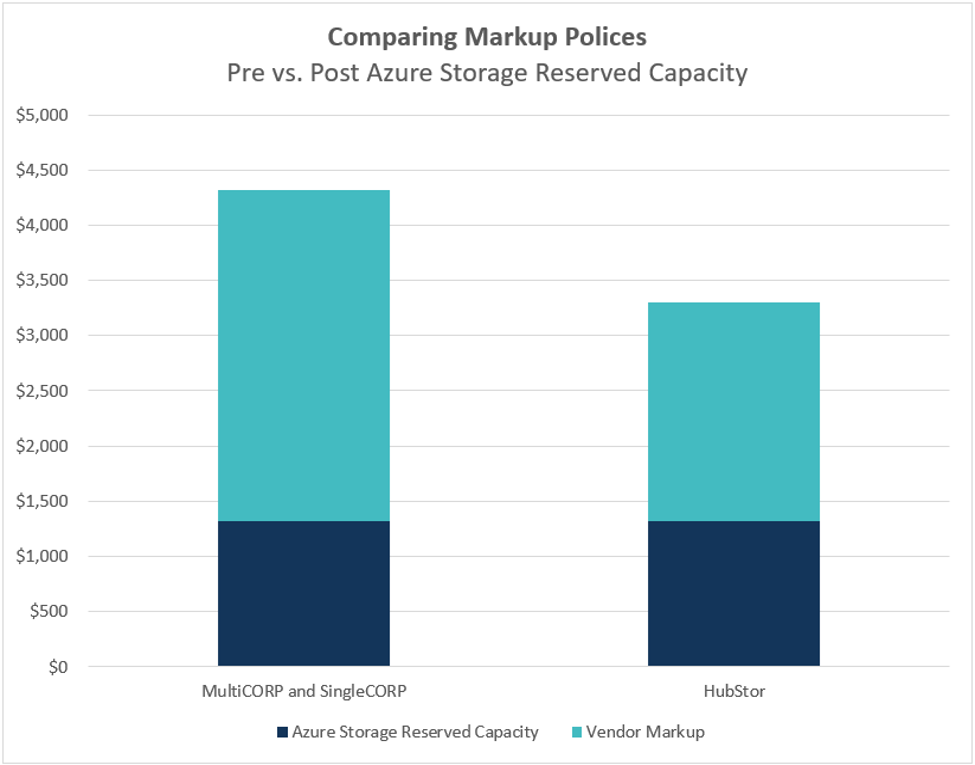In our previous post, When not to use Azure Storage Reserved Capacity, we detailed the carrots and sticks when it comes to purchasing Azure Storage Reserved Capacity. While the benefit is the cost savings possible, ranging from 34% for data on the Hot tier to 17% for data on the Archive tier, there were some caveats we pointed out which you should consider before moving ahead with Azure Storage Reserved Capacity.
In this post, I’ll add one more item to your list of considerations, as follows:
Not all vendors with solutions built on Azure Blob Storage pass along the cost savings of Azure Storage Reserved Capacity to their customers.
Let’s take a step back.
In some scenarios, companies are using Azure Blob Storage directly via some existing Microsoft products or an in-house application. However, many companies instead consume Azure Blob Storage indirectly through a CSP or SaaS vendor solution like HubStor.
A vendor solution bridges the gap between the Azure cloud and your various production workloads (think VMs, on-premises shared storage, email journaling, Office 365, or whatever it is the vendor’s solution provides in terms of backup/archive/data management).
When it comes to Azure Storage Reserved Capacity, these vendors fall into one of three categories:
- Multi-tenant – Vendors using a multi-tenant model, in which your data must be stored inside their Azure subscription, and is co-mingled with data from other companies. These vendors will usually not expose any savings from Azure Storage Reserved Capacity to their customers, though internally, they are likely using it to improve their margins.
- Single-tenant that excludes prepay savings – Vendors using a single-tenant model, but which have fine-print to exclude any savings from Azure Storage Reserved Capacity from their pricing model. In some cases, the vendor has pricing somewhat decoupled from the Azure spend, but in other cases, vendors whose pricing is directly tied to a customer’s Azure spend as a markup will still exclude any Azure Storage Reserved Capacity savings from the markup calculation. This is important to understand, as it will significantly impact your expected savings when purchasing Azure Storage Reserved Capacity.
- Single-tenant that passes along prepay savings – Vendors like HubStor who are using a single-tenant model, with pricing directly derived from a customer’s Azure spend. These vendors, of which there are few, pass any savings from Azure Storage Reserved Capacity straight back to their customers. In the case of HubStor, our price is simply a markup on the underlying Azure costs AFTER factoring in any Azure Storage Reserved Capacity savings, meaning that using Azure Storage Reserved Capacity will reduce the price of Azure AND HubStor.
When it comes to selecting a vendor, it’s essential to understand which of these three categories, a given vendor falls into, since this can have a significant impact on your costs. For comparison sake, let’s model the three vendor scenarios:
- MultiCORP. A standard multi-tenant provider.
- SingleCORP. A standard single-tenant provider which excludes Azure Storage Reserved Capacity savings from markup calculations.
- HubStor. A single-tenant provider which transfers Azure Storage Reserved Capacity savings directly to you, the customer.
For simplicity’s sake, let’s assume that all three companies are pricing out 200 terabytes of Cool storage with a 3-year Azure Storage Reserved Capacity, and that each vendor’s pricing is a 150% markup. With these assumptions, here’s the difference in monthly storage costs:

Figure 1. Total cost per vendor model for 200 TB Cool storage with Azure Storage Reserved Capacity.
As you can see, the question of which markup model your vendor uses when dealing with Azure Storage Reserved Capacity has a substantial and immediate impact on your overall vendor costs, even when talking about relatively modest amounts of data.
Using a vendor like HubStor, which passes on the underlying Azure savings AND applies their markup to the reduced Azure costs dynamically, is unique in helping you reduce your cloud costs.
HubStor uniquely provides a unified SaaS backup and archive platform, built on Azure Blob Storage, that helps you simplify backup for on-premises, PaaS, and SaaS workloads. We fully support Azure Storage Reserved Capacity, passing those savings back to our customers.
In addition to backup, you can solve your archiving challenges on the same unified data platform, including immutable retention for compliance, file server cloud tiering, legal discovery, GDPR, application retirement, and message journaling.
If you’re looking for a reliable cloud platform that can simplify a number of your backup and archiving challenges, consider HubStor.
To learn more about HubStor, contact us for a pricing estimate.



